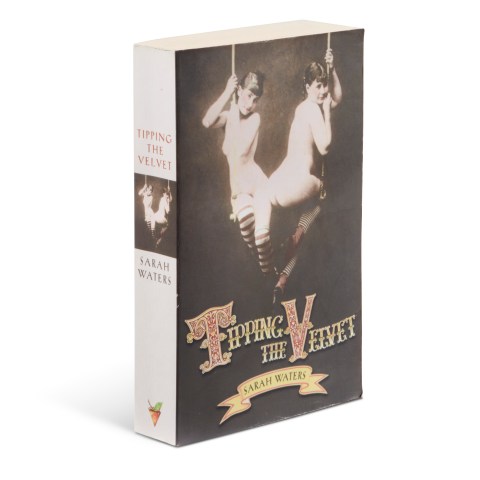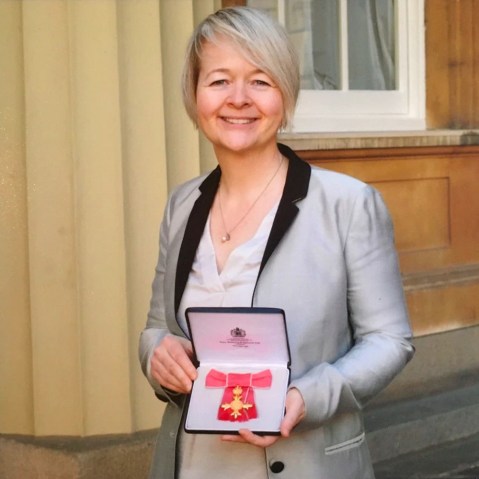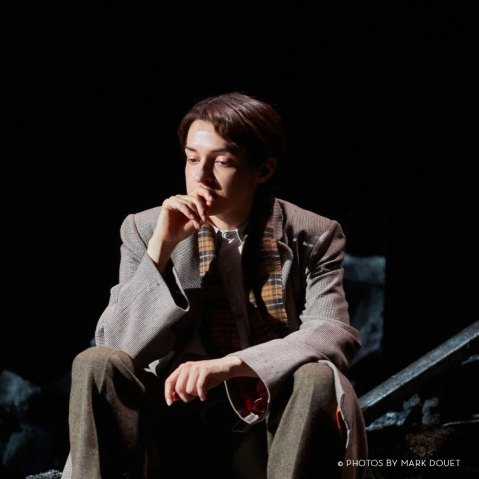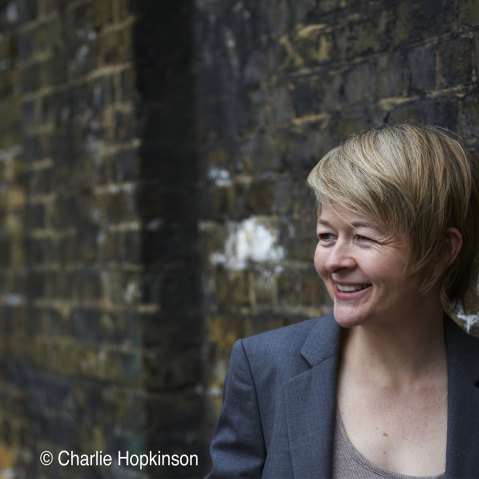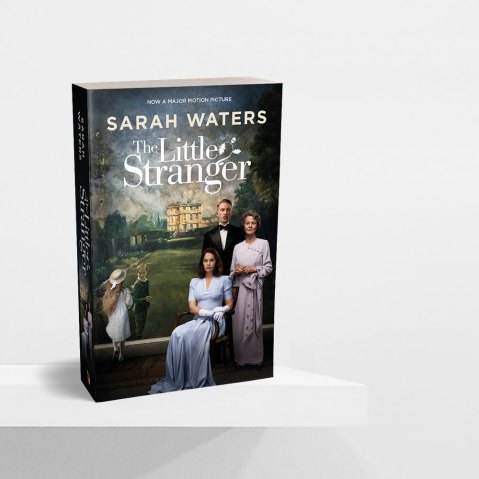Sarah Waters’ Desert Island Movies

In November 2015 Sarah Waters was invited to choose her ten Desert Island Movies for an interview with Jo Botting at the Cinema Museum, London. Here, Sarah talks through the list she came up with.
The Singing Ringing Tree (1957)
Back in the school holidays of the early 1970s this film seemed always to be on tv. It’s one of the first movies I remember watching – and watching alone, able to think my own thoughts about it. It contained much that was perplexing, not least the English-language voice-over with the German soundtrack half-audible beyond. But the fairy-tale motifs and the synthetic landscape are the universal ones of childhood, and the strangeness simply added to the charm. (The colours, however, always take me by surprise: they were lost on our black and white telly.) As an adult I’ve discovered that the film was made by a state-run studio in the GDR. As a fair-haired little girl, what impressed me most vividly about the story was the haughty blonde princess losing her looks – though I remember being very moved by the fact that she regains her prettiness by learning to be kind. This clip gives a sense of the general craziness of the film, and features one of its most memorable characters, the giant rolling-eyed goldfish.
Jason and the Argonauts (1963)
This is another film from my childhood; I remember enjoying it with my dad. It features the fabulous stop-motion animation of Ray Harryhausen – so much creepier and more satisfying than modern CGI. There are many terrific moments in this film: the ship’s talking figurehead; the harpies, meanly trapped by a net; Neptune rising from the waves to push apart the Clashing Rocks; the bronze giant, Talos, defeated when the plug on his ankle is removed, letting out a gush of ichor… But this clip, featuring an army of fighting skeletons, is perhaps the most iconic of all.
The Pit and the Pendulum (1961)
I was addicted to horror films when I was a child, so I’ve chosen this film to sort of stand in for them all – though it has always been one of my favourites, featuring as it does premature burial, madness, diabolical twists, and a magnificently fruity performance from Vincent Price – what’s not to like? It was directed by Roger Corman, who clearly understood the link between the Gothic and the unconscious: the claustrophobic, colour-saturated narrative continually trembles on the lip of nightmare, and even now it still provides a couple of genuine chills. In this clip we see the pendulum in full, terrifying swing. (What I notice as an adult, in fact, is what a hefty piece of equipment it clearly was: apparently the actor strapped beneath it had to wear a sort of metal cummerbund underneath his shirt, just in case…)
Quatermass and the Pit (1967)
This film contains so many elements that are close to my heart – London history, archaeology, alien conspiracy theories, poltergeists, telekinesis, urban myth – that if I was ever somehow to be translated into a movie, this is the one I would be. I must have seen it only once or twice when I was a child, but it made a huge impression on me – though, as with The Singing Ringing Tree, it always gives me shock to watch it now and realise it’s in colour. It was scripted by the brilliant Nigel Kneale, whose other screenplays include a memorable BBC adaptation of The Woman in Black (I watched that one Christmas and threw up my turkey dinner in fright). When perusing the map of the London Underground I sometimes want to look for the film’s fictional station, Hobbs End. And I can never see an urban building site without thinking of the story’s climax, where heroic Dr Roney destroys the giant horned devil that has reared up in the sky by swinging a metal crane into it. Genius. This link is to the film’s over-excited trailer.
The Lavender Hill Mob (1951)
This is another great London film, which makes lovely use of many different locations in the city (some of them clearly still devastated from the bombs of the Second World War). I’ve chosen it partly for its own sake – it’s a perfect little film – but also to represent Ealing comedies generally, which contain some more of my favourite movies: The Man in the White Suit, Kind Hearts and Coronets, Passport to Pimlico, and The Ladykillers. The genre was often in my mind while I was writing The Night Watch. I wanted with that novel to sort of open up a little tear in the fabric of British social history, and insert my characters into it. So the book contains many tiny Ealing echoes – with its heroine Kay, for example, working at an ambulance station in Pimlico, and having a home on Lavender Hill, in a house which (for me) recalls the teetering bomb-damaged house of The Ladykillers… This is a link to the film’s trailer, which captures all its gentle humour, its distinctly post-war celebration of ‘little’ people with big ambitions.
A Star is Born (1954)
Back in 2008 I was approached by the BFI to nominate a film that I would save for future generations; and the film I chose was this one. Like all the best musicals, it’s really a ‘film with music’ – though it stretches that conceit to the limit, being full of dizzyingly extended numbers and songs within songs. But it’s also a fiercely intelligent movie about the movie industry itself, and it features two glorious stars, Judy Garland and James Mason. It’s a serious tear-jerker, and I can never watch it without sobbing; I’m not sure I’d want to play it too many times, all alone on a desert island. This clip, however, I can watch again and again. I love the casualness of the setting, with the band fooling around at the end of a working night. Esther’s at the high point of her art here, belting it out simply for the love of it; by comparison, the songs she’ll be made to sing later, as the big star Vicky Lester, are trite and stressful. The gestures are theatrical, the lyrics are all about longing and regret; the performance is rendered extra poignant by what we know about Judy’s own future… Then she gives that beautiful saving giggle, right at the end.
The Rocky Horror Picture Show (1975)
I remember exactly when I saw this film, and how I came to see it. I had watched Fame, the movie, when I was sixteen, and there’s a bit where one of the students goes to see The Rocky Horror Picture Show – you see the film going on in the cinema, with the audience joining in. I had never heard of the movie, didn’t know a thing about it, but with the unerring instinct of the small-town teenage self-inventor I thought: That’s for me! When my boyfriend and I made a trip to London a year or so later, I tracked down a cinema that seemed to have Rocky Horror and Young Frankenstein on perpetual loop. We went, we saw it, and it confirmed something I was already beginning to suspect: that queer people could be cooler, funnier and much, much sexier than straights. I’ve seen the film many times since then; recently it has begun to feel like a period piece, a little bit tiresome. But I shall love it for ever, and I often play the songs; they never fail to cheer me up. This clip provides lyrics, so you can sing along! And remember: It’s just a jump to the left…
Alien (1979)
I can still recall the stir this film caused when it appeared, though that must have been several years before I actually saw it; it was the kind of movie that got talked about in the school playground. If it looks a bit generic now, that’s only because it’s been so influential. It seemed to reinvent the sci-fi genre – its grungy spaceship, manned by a sweaty, unheroic, squabbling crew, creating a template that’s been followed by many movies since. I love this film for many reasons. It offers a proper narrative, with the gradual build-up of mood and intrigue. It has a wonderfully strong (and fabulously grimy) female lead, in the form of Sigourney Weaver’s Ripley. It’s a brilliant modern Gothic (really an offspring of The Pit and the Pendulum, with the same preoccupation with dankness, darkness, repression, possession, simply transferred to a hi-tech setting). And it takes its subject with beautiful seriousness, drawing its motifs from popular culture yet treating them with artistry and emotional realism. In that, it resembles some of the other great horror movies of the 1970s – The Exorcist, say, and The Omen. This clip captures one of its most game-changing moments.
Brief Encounter (1945)
I first saw this as a young teenager, perhaps on a Saturday afternoon, when, in those days, old black-and-white movies were regularly shown on tv. I’ve watched it many times since then, and have found different things in it at different moments. Like The Lavender Hill Mob it seems to me to be a perfect film, in the sense that all its elements are in exactly the right place. And though it’s easy to make fun of the stiff-upper-lipness of it, I always find watching it a rather agonising experience – it’s so impossible for its heroine, Laura, to find a place, unobserved, away from the demands and responsibilities of family and community, in which simply to think and to feel. It was scripted by Noel Coward, who as a homosexual man in pre-Wolfenden Britain must have known a bit about the perils of forbidden desire. But the film is about class as much as about sex – about the extremity of passion that can be contained in a genteel life, and in a middlebrow form (something I’ve explored myself, I suppose, in The Paying Guests). This clip is of the final few minutes of the film: it uses camera work in a really interesting way, to point up the intense interiority of Laura’s story – and it employs the small, prosaic detail of her disarranged hair to absolutely devastating effect.
Cabaret (1972)
This film had a huge impact on me when I first saw it on tv at the age of about fourteen – partly, I think, because of its distinctly queer allure. (Brian: ‘Screw Maximilian!’ Sally: ‘I do.’ Pause. Brian, laughing: ‘So do I.’ I remember being absolutely electrified by that moment, back in 1980!) I still think it’s one of the best musicals ever – though what strikes me most now is how youthful its stars are (and, in the case of Michael Yorke, how achingly beautiful). This clip might seem a rather unimaginative choice, given how lush and visually exciting some of the film’s other musical moments are. But, in all sorts of ways, it forms a nice counterpoint to the earlier clip from A Star is Born – and the song is one of my all-time favourites. I find it hard to admit to admiring Sally Bowles. She represents all the things I’ve striven hard not to be in my life: sleazy, annoying, feckless, selfish, irresponsible, a show-off. Secretly, however, I’d like to be her…
Sarah first shared her Desert Island Movies in conversation with Jo Botting at London’s Cinema Museum. To find out more, visit their website and follow them on Twitter @CinemaMuseum.



